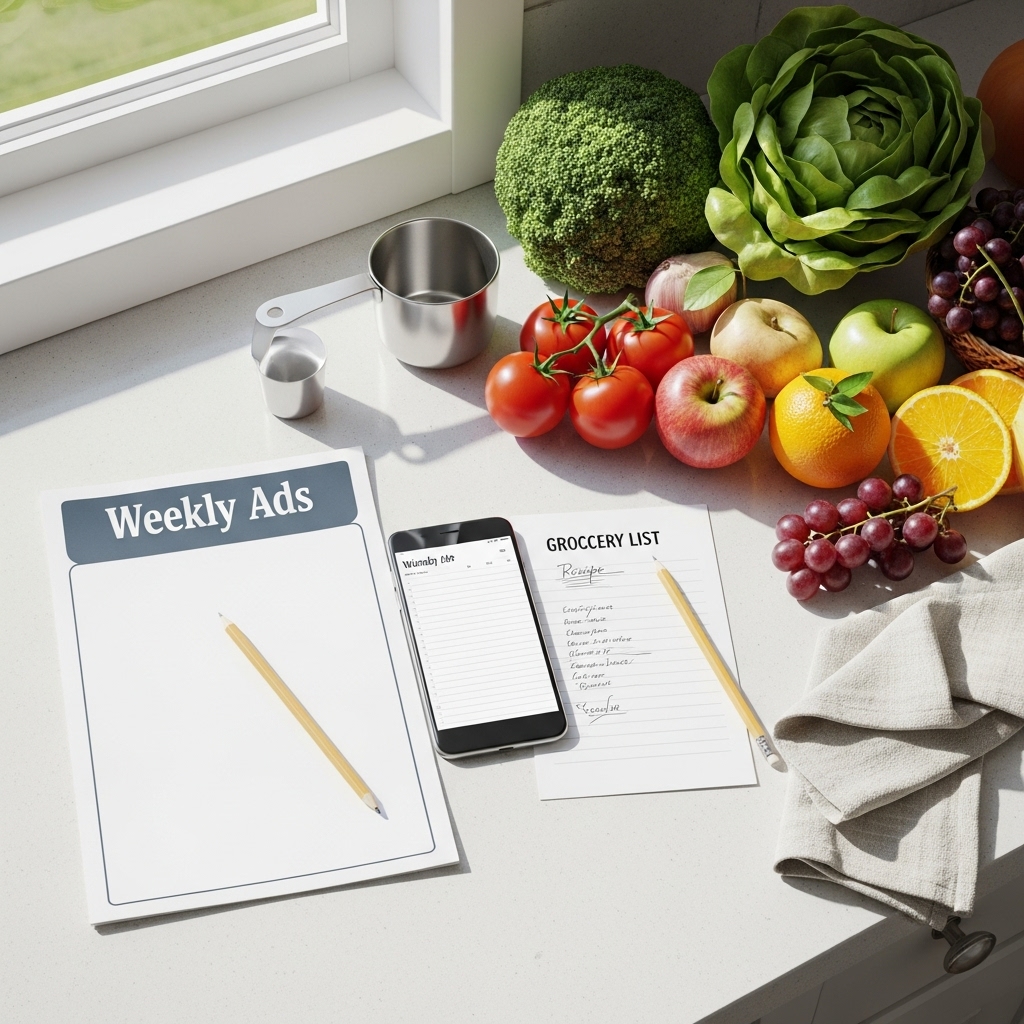Weekly supermarket deals in Naperville, Illinois are more than a rotating list of promotions—they are a rhythm you can learn and use to plan simple, satisfying meals. From produce and pantry staples to household basics and deli favorites, featured items cycle in patterns across the seasons. When you understand those patterns and match them to your household’s habits, shopping becomes smoother and more intentional. To begin each week with clarity, skim current weekly deals so you know which categories to lean into as you build your list.
How weekly ads shape a smarter cart
Weekly ads reflect what is abundant, timely, and exciting right now. A strong ad gives you a snapshot of where to focus: produce that is peaking, pantry items that are featured, and specialty goods that might be worth exploring. Treat the ad as a guide, not a script. Use it to anchor your core meals for the week, then fill in with staples you consistently need. This approach keeps you grounded and prevents distraction by every single promotion.
If you are new to planning around ads, start with three anchor categories: produce, proteins, and pantry. Choose one or two featured produce items, one dependable protein category, and a pantry staple that supports multiple dishes. Build your meals around these anchors, and you will see your cooking flow improve immediately.
Seasonal cycles you can trust
Naperville’s seasons bring predictable shifts to ads. In late spring and summer, fresh fruits and vegetables often take center stage, while cool-weather months may highlight soups, baking supplies, and hearty staples. Around major holidays, expect themed assortments and special ingredients for celebratory meals. When you align your menu with the season, you enjoy better flavor and often more abundant variety.
Use the season to guide your storage strategy as well. In warm months, focus on quick-cook meals and fresh sides that make the most of peak produce. In colder months, keep an eye out for items that support simmered dishes and batch cooking. The goal is comfort and ease, not complication.
Produce strategy: freshness first
Start your plan with produce. Choose two featured fruits and two vegetables that can serve multiple purposes. A leafy green can anchor salads early in the week and become a cooked side later. A versatile vegetable can appear in stir-fries, sheet-pan dinners, and soups. Build meals that use these items early while they are at their best, then shift to heartier produce later in the week.
When you shop, look for crisp textures, vivid color, and tidy displays. If you are shopping on the weekend, arrive early or later in the day to avoid the midday rush. Keep your produce storage ready at home: clear space in crispers, prepare a container for washed herbs, and set up a simple rinse-and-dry station so you can transition straight from shopping to prepping.
Proteins and prepared items: plan for flexibility
For proteins, pick options that can flex between meals. If you plan a stir-fry one night and a salad the next, a single protein can link both meals. If you enjoy prepared items, choose those that pair with fresh produce and grains for speedy dinners. The trick is to buy with a plan, not just because something is featured. When you know exactly how you will use it, featured items become building blocks rather than random extras.
Think in terms of two quick meals, one slower weekend dish, and one leftover night. This rhythm respects busy schedules and reduces waste, especially when aligned with featured categories in the ad.
Pantry and freezer: the week’s safety net
A resilient pantry is the secret to successful weekly planning. Choose one or two featured pantry staples that work in multiple dishes—grains, sauces, or beans. Round them out with freezer standbys that help you bridge gaps when plans change. This combination lets you react nimbly if a featured item sells faster than expected or if your week suddenly fills with activities.
Organize your pantry so featured items are front and center. Keep open packages in clear containers with labels, and store back-up items behind them. When your pantry is tidy, you waste less and enjoy cooking more.
Reading the ad like a pro
A quick scan is fine, but a closer read yields better meals. Look for patterns across pages: are there bundles, themes, or meal ideas implied by the featured items? Notice where store-prepared foods align with fresh produce or bakery items. If a certain cuisine seems to be highlighted, consider a themed dinner that uses several featured elements. This creative lens makes meal planning fun rather than tedious.
Highlight two “must-grab” features and two “nice-to-try” items. This simple structure keeps your cart prioritized while leaving room for discovery. If one of the must-grab items is low when you shop, pivot to a backup from the nice-to-try list.
Building your list around featured items
Create your list in three columns: core meals, staples, and experiments. Under core meals, write dishes that use featured items directly. Under staples, list what you run through every week. Under experiments, include one or two items from the ad that you want to try. This format balances practicality with curiosity and prevents your cart from becoming a patchwork of unrelated promotions.
When you reach the store, shop your core list first, then staples, then experiments. If time runs short, you will still leave with the ingredients that matter most for the week ahead.
Midweek adjustments and second looks
Sometimes, the best time to act on a featured category is midweek. Crowds thin, displays are refreshed, and you can reassess what your household still needs. If you cooked more than expected and have leftovers, you might skip a planned item and instead pick up fresh produce to complement what is already in the fridge. Midweek is also a good time to revisit weekly deals to see if a newly featured item fits your weekend plans.
Naperville-specific timing and traffic
Naperville’s busy corridors mean timing matters. Early weekday mornings often offer calm aisles and well-stocked departments. Weekend late afternoons can also be manageable. If you are coordinating multiple errands, choose a store along your main route to avoid backtracking. A smooth trip saves energy and helps you focus on quality rather than navigating crowds.
Meal prep that follows the ad
Turn featured items into a simple prep session. Wash greens, chop hearty vegetables for roasting, and cook a versatile grain. Store components so they are ready for quick assemblies on busy nights. When the week accelerates, you will thank yourself for this head start. Prep does not have to be elaborate; even 30 minutes can set the tone for calmer meals.
Family-friendly strategies
Involve the household by letting each person choose one featured item to include in a meal. This small decision boosts buy-in and keeps picky eaters engaged. If schedules are hectic, plan a build-your-own night using featured produce and pantry items. This approach minimizes stress while keeping meals balanced and colorful.
Frequently asked questions
How do I avoid overbuying when ads look exciting? Use a three-column list: core meals, staples, experiments. Shop in that order and cap experiments at two items per week.
Can I plan a week of meals from featured items alone? Yes, but balance is key. Use featured items as anchors and supplement with staples you know your household finishes reliably.
When is the best time to shop in Naperville for ad items? Early weekday mornings and late weekend afternoons are often calmer. If a feature is popular, go earlier in the cycle to improve selection.
What if a featured item is out of stock? Have a backup in mind from the same category. A flexible plan keeps your meals on track without extra trips.
How do I build variety week to week? Rotate cuisines and cooking methods. If you focused on roasting last week, plan stir-fries or salads this week, guided by different featured produce.
How do I reduce food waste when planning with ads? Reuse ingredients across two or three meals and prep components right after shopping. Keep an eye on perishables and plan a leftovers night.
Should I revisit the ad after my main shop? A midweek second look can reveal new ideas and help you top up essentials with intention, not impulse.
Can I do all this with a tight schedule? Absolutely. Focus on anchors, keep your list short, and prep a few components. Small habits create steady wins.
Make this week’s Naperville shop smooth and satisfying
When you treat weekly ads as a planning tool, shopping becomes simpler and meals fall into place. Start by scanning current weekly deals, pick your anchors, and build a list you can execute quickly. With a calm plan and a flexible mindset, you will turn featured items into meals that fit your life—without extra trips or stress.




